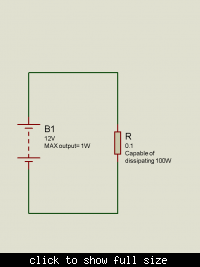habibparacha
Junior Member level 2
Hi,
A theoretical Question. I have a battery and a resistor attached in series. Battery is 1V(maximum power it can diliver is 1W) and the resistor is 0.1Ohm(Capable of dissipating 100W). What will be the voltage and current across the resistor.
If we calculate by the power supplied by the battery than V=IR (Ohm's law fails) and otherway around KVL fails. Any help will be appreciated.
A theoretical Question. I have a battery and a resistor attached in series. Battery is 1V(maximum power it can diliver is 1W) and the resistor is 0.1Ohm(Capable of dissipating 100W). What will be the voltage and current across the resistor.
If we calculate by the power supplied by the battery than V=IR (Ohm's law fails) and otherway around KVL fails. Any help will be appreciated.
